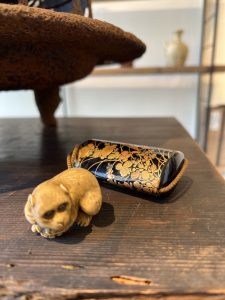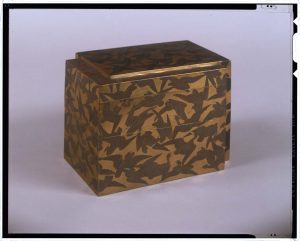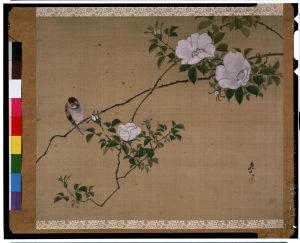帝室技芸員 柴田 是真(愛知県名古屋市千種区姫池通 骨董買取 古美術風光舎)
2024.10.10
皆様こんにちは、スタッフYでございます。

時折お届けしております帝室技芸員シリーズ。本日は、マルチな天才漆工家・絵師・日本画家、「柴田是真」についてお届けいたします。
恥ずかしながら柴田是真についてはほぼ不勉強なスタッフYでして、よって本日は本当に「うんうんなるほど。」と、頷きながらブログを綴ってまいりたいと思います。
柴田是真(しばた・ぜしん)は、幕末から明治にかけて活躍した最後の江戸職人と呼ばれておりまして、なんと、蒔絵・漆絵・絵画などを手掛け、マルチな才能で絶大な人気を誇りました。絵画で培った構図力と漆工芸という技術を掛け合わせた驚異的な作風は、現在の日本美術界に繋がるためになくてはならない存在とされております。
「ZESHIN」の作品は日本のみならず世界から評価されており、海外にもコレクターが多い作家の一人なのですが、どうやってジャンルの枠を超えたマルチな作品を作り続けたのか気になるところ。また、どのような人物だったのかも気になるところです。

烏鷺蒔絵菓子器(明治期)東京国立博物館画像より
柴田是真は1807年2月7日、江戸両国橋2丁目に生まれます。越後出身の宮大工の家系であり、父は浮世絵を学んでいたということで、芸術を身近に感じられる環境で育ちました。11歳の頃、蒔絵師・古満寛哉(こまかんさい)の元に入門し、蒔絵を学び始めます。学ぶにつれて図案に頼るのではなく自らオリジナリティのある下絵を描ける職人になりたいと志し、16歳の頃には四条派の画家・鈴木南嶺(すずきなんれい)に入門します。少年時代より蒔絵と日本画を並行して学んでいたようですね。(すでにマルチな天才の片鱗が見え隠れしますが。)そして、20歳で蒔絵師として独立しますが、当時人気が高まっていた浮世絵師・歌川国芳が是真の絵に感動し、弟子入りを申し込んだというエピソードも残っています。
1830年是真24歳の頃には、さらに四条派の絵についてさらに深く学ぶため、当時絵画が盛んだった京都へ移り住みます。京都では絵画だけではなく漢字も学び、他の絵師との交流を深め人脈を広げていたようです。その1年後に江戸に戻り師匠・鈴木南嶺と再会した際に絵を見せると、その大変な進歩に感心され、それを機に「是真」を称するようになりました。ですが、画家としての評価は先に得たものの蒔絵師としてはなかなか評価がされず、苦しい下積み時代を送っていたようです。
そんな柴田是真ですが、1840年34歳のときに転機が訪れます。江戸の住吉明徳講(砂糖商人の組合)に委嘱され、王子稲荷神社に奉納するために「鬼女図額面」を描きます。その絵図が大変な評判を呼び一躍有名となりました。これ以降、是真は漆芸家・絵師両方の作家として精力的に活動を行っていきます。
その後の是真の人気は日本に留まることはありませんでした。1873年のウィーン万国博覧会に「富士田子浦蒔絵額面」を出品し進歩賞牌を受賞すると、「ZESHIN」として海外にも名が知られることになります。
1876年のフィラデルフィア万国博覧会でも賞牌を受けるなど、国内外の博覧会・展覧会で多くの賞を受賞し、明治23年に帝室技芸員に任命されます。1891年に85歳でこの世を去りますが、幕末から明治の激動の時代の中で常に学びを忘れず、芸術に身を捧げる生涯でありました。
そんな蒔絵師・絵師・漆芸家として一線で活躍した天才作家柴田是真ですが、彼の蒔絵は他の蒔絵師とは違い、下絵から蒔絵まですべての工程を一人でこなすという驚くべき才能を発揮しました。
さらに勉強熱心だった是真は、作品を手に取る人々の好みも研究しております。当時江戸に生まれた人々は、確かな技術や知識に基づいた作品でも、それをひけらかすことのない滋味のある良いものを好んでいました。そのため是真の作品全体からは「江戸らしさ」や「いき」を感じさせ、洒脱でウィットに富んだ画風というところも特長のようでして、時代の流れや好みをキャッチすることも得意だったのでしょうね。
生涯新しいものへの探求心と研究・制作をし続け、さらには画家、職人の両方の顔を併せ持つ是真の作品は、これまで習得した様々な技術がすべてが溶け込んだ綿密で繊細ながら豪快さも残る独自の世界観を表現しています。
そんな探求心のとどまることを知らない是ですが、1845年幻とされていた技術「青海波塗」を復元します。
青海波塗とは、薄く塗った漆が生乾きのうちに刷毛などで波文を描く技法のことでして、元禄時代に活躍した絵師・青海勘七(せいかい・かんしち)が作り出して以来途絶えていた技術でした。漆絵に関しては、蒔絵で学んだ技法を応用し、青銅塗・四分一塗・鉄錆塗・砂張塗・紫檀塗・墨形塗といったさまざまな変わり塗りの新技法を作り出しました。このように深い知識とジャンルの枠にとらわれない発想で多くのオリジナリティあふれる芸術品を制作し続けました。

花鳥図(椿雀図)明治期 東京国立博物館画像より
そんな天才について、世の中には様々な分野の天才がおり、彼らや、彼らを語る人々が様々な天才の定義を語っておりますよね。
例えば、トーマスエジソンは「天才とは、1%のひらめきと99%の努力である」、物理学者アルバート・アインシュタインは「天才とは努力する凡才のことである。」、野口英世は「誰よりも三倍,四倍,五倍勉強する者,それが天才だ」などと語り、「天才も努力するのだ」と、いったフレーズをよく耳にしますが、この柴田是真に限ってはちょっと違う気がしまして。
好奇心がいつも前のめりで止まらない姿が、「天才とは、好奇心と努力の垣根が止まらなくなった究極の芸術オタク」じゃないかな笑と、ふと思いましたが、これはあくまでも私見。
みなさまも天才の定義、ぜひ考えてみてください。
それではごきげんよう。
Hello everyone, this is Staff Y.
This is a series of articles on the Imperial Household Artists, which we have been bringing you from time to time. Today, we would like to introduce you to the multi-talented genius lacquer craftsman, painter, and Japanese-style painter, “SHIBATA Zeshin.
I am ashamed to admit that I am almost completely ignorant of Koreshin Shibata, so today I really nodded my head as I wrote this blog. I will write this blog while nodding my head in agreement.
Shibata Zeshin is called the last Edo craftsman who was active from the end of the Edo period to the Meiji period. He worked on maki-e, lacquer painting, and painting, and was extremely popular for his multiple talents. His amazing style, which combines the compositional skills he cultivated in painting with the techniques of lacquer craft, is considered indispensable to the current world of Japanese art.
Zeshin’s works are appreciated not only in Japan but also in the world, and he is one of the artists who have many collectors overseas, and we are curious as to how he continued to create multiple works that transcended the boundaries of genres. We also wonder what kind of person he was.
Zeshin Shibata was born on February 7, 1807 in Ryogoku-bashi 2-chome, Edo. At the age of 11, he began learning maki-e under the tutelage of Koma Kansai, a maki-e artist. As he learned more and more, he wanted to become a craftsman who could create his own original maki-e designs, rather than relying on the designs themselves. It seems that he studied maki-e and Japanese painting at the same time from his boyhood. (Although there are already glimpses of his multi-talented genius). There is an episode that Utagawa Kuniyoshi, a popular ukiyoe artist at that time, was so impressed by Koremoto’s maki-e that he asked him to be his apprentice.
In 1830, when Koremoto was 24 years old, he moved to Kyoto, where painting was flourishing at the time, to further study the Shijo school of painting. In Kyoto, he learned not only painting but also Kanji (Chinese characters), and seems to have deepened his contacts with other painters and expanded his personal network. When he returned to Edo a year later and met again with his master Suzuki Nanrei, he showed him his paintings and was impressed by the great progress he had made, which led him to take the name “Zeshin. However, although he had already gained recognition as a painter, he did not receive much recognition as a maki-e artist, and he spent a difficult period as a lowly apprentice.
In 1840, at the age of 34, a turning point came for Shibata Zeshin. Commissioned by the Sumiyoshi Meitokou (sugar merchants’ association) in Edo, he painted “Oni Onna Zu (Demon Woman)” for dedication to the Oji Inari Shrine. The painting was very well received and became famous. From this point on, Koremoto worked energetically as both a lacquer artist and painter.
His popularity was not limited to Japan, and when he exhibited his “Fuji-Tagoura maki-e maki-e frame” at the Vienna World’s Fair of 1873 and received the Progress Award, he became known abroad as “ZESHIN.
He received many awards at domestic and international expositions and exhibitions, including a prize at the Philadelphia World’s Fair in 1876, and died in 1891 at the age of 85.
Unlike other maki-e artists, Shibata demonstrated an astonishing talent in all processes of maki-e, from preparatory drawing to maki-e, all done by himself.
Furthermore, Koreshin, who was a diligent student, also studied the tastes of the people who would take his works in their hands. People born in Edo (present-day Tokyo) preferred works that were based on solid techniques and knowledge, but that did not flaunt them. Therefore, Koremoto’s works as a whole give a sense of “Edo style” and “iki,” and his style is characterized by stylishness and wit, and he must have been good at keeping up with the trends and tastes of the times.
His works express a unique view of the world that is meticulous, delicate, and dynamic, blending all of the various techniques he has mastered.
In 1845, Koremoto restored “Aomiha-nuri,” a technique that had been thought to be a mirage.
Seikai-no-ha-nuri is a technique of drawing wave patterns with a brush or other means while a thin layer of lacquer is still drying, a technique that had been discontinued since it was created by Seikai Kanshichi, a painter active in the Genroku era (1688-1704). In the field of lacquer painting, he applied the techniques he learned from maki-e to create various new techniques of variegated lacquering, such as bronze, shibu-nuri, tetsubun-nuri, sunabari-nuri, shiban-nuri, and sumi-gata-nuri. With such in-depth knowledge and genre-defying ideas, he continued to produce many original works of art.
There are geniuses in various fields in the world, and they and the people who talk about them give various definitions of genius.
For example, Thomas Edison said, “Genius is 1% inspiration and 99% effort,” physicist Albert Einstein said, “A genius is an ordinary genius who works hard. We often hear phrases such as “A genius is a genius who studies three, four, or five times harder than anyone else,” or “A genius also works hard.
I suddenly thought that “a genius is the ultimate art nerd whose curiosity and hard work have become unstoppable,” but this is just my personal opinion.
I hope you all will consider the definition of genius.
Have a good day.
*******************
ご実家の整理やお片付けなどをされている方のご相談などが多くございます。
お片付けなどくれぐれもご無理のないようになさってくださいませ。
風光舎では古美術品や骨董品の他にも絵画や宝石、趣味のお品など様々なジャンルのものを買受しております。
お片付けをされていて、こういうものでもいいのかしらと迷われているものでも、どうぞお気軽にご相談下さいませ。
また風光舎は、出張買取も強化しております。ご近所はもちろん、愛知県内、岐阜県、三重県その他の県へも出張いたします。
なお、毎月21日の持込鑑定会では無料鑑定・買取・ご相談など、ご予約なしで承っております。
ご近所の皆さま、ご遠方のみなさまも、お気軽にお越しくださいませ。
まずは、お電話お待ちしております。
愛知県名古屋市千種区姫池通
骨董 買取【古美術 風光舎 名古屋店】
TEL052(734)8444
10:00-18:00 OPEN
#出張買取#骨董#古美術#骨董品#絵画#版画#茶道具#刀剣#彫刻

